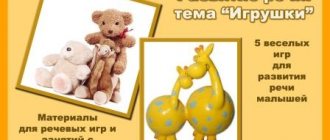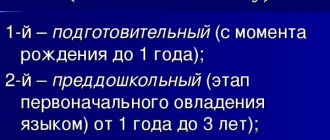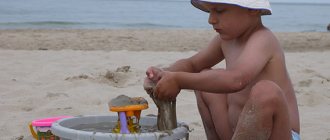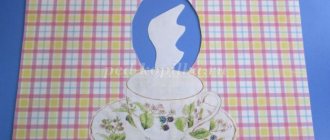Many children who are not even two years old can already speak well. Conversely, sometimes two-year-old toddlers master communication skills much more slowly than younger children. Therefore, it is necessary and important to work with your child - special games for speech development can help.
Source: instagram @davaipoigraem_kazan
Do not forget about the important rules that should be followed during speech development classes.
Games for developing speaking skills
The basis for such games is ordinary speech. The child gains useful experience of fluent and grammatically correct spoken language. Games are useful for stimulating positive emotions if a child has isolated himself, withdrawn, or become offended.
"Skilled rhymers." It is useful to turn to such a game when you are offended by a peer, brother or sister.
Make up, make up, make up and don’t fight anymore, and if you fight, you’ll be left without a friend.
* Hey, hand, shake, shake, just don’t fight anymore.
* Relax your hand, relax and don’t pinch anymore.
* Oh, my hand is stuck! I let go of my hand and grab him by the body. You call it good, I let go of my hand.
Playful rhymes to help you overcome feelings of resentment.
Take away the insult - you are forgotten anyway,
Run into the yard, climb over the fence,
Get on your horse and ride away from me!
Speech game with kids 4. Showing a skit. Game in a cafe.
The author of the idea is Tatyana, the mother of little Gleb.
Speech game for little ones. Tatyana turned the nursery rhyme into a song. After each line, a simple word for a child to imitate is sung - the onomatopoeic word bulbul. Even if the baby is just starting to speak, he will already be able to sing along with you this word. And he offers to show the child a scene using lines from the verse: take a saucepan, put cereal in it, stir with a spoon, cover with a towel or handkerchief and call our toys - little animals - for breakfast. Using a spoon, we transfer the cereal from the pan into their bowls and feed all the guests our porridge.
The child can be involved in the process of transferring cereals into a pan with a large spoon or small glass, mixing water and cereals (development of fine motor skills and sensorimotor coordination).
Speech game for older children. When the child grows up and begins to speak more freely, you can turn this skit into a speech game in a cafe.
Preparing for the game: You need to come up with a name for our home cafe, draw a menu with your child (or cut and paste pictures from advertising brochures depicting products).
The child will be a cook, and the mother will be an assistant cook. The cook prepares porridge and calls everyone for lunch. He reads a poem by Nina Pikuleva, treats him to porridge, asks everyone if they liked it, whether the guests will come to the cafe again, asks to leave a review about the treat - his porridge (you need to “praise the porridge” - that is, choose figurative expressive words: what kind of porridge? Crumbly, soft, sweet, tasty, fluffy, aromatic, fragrant. Upon completion, we clean the table and wash the dishes (game actions).
Why did Tatyana introduce washing and cleaning into the game in the cafe? Because Gleb really loves to participate in them. And this is also an individual approach to the child - those actions are introduced that are significant for a particular child and which he prefers. This is very important for interaction with any baby!
Development of a child's grammatical abilities
These games help develop children's grammatical abilities without cramming the letters of the alphabet, without the dull reading of syllables from a book.
"Let's remember the letters." Goal: to help the child remember the letters of the alphabet, relying on auditory, visual, and muscle memory.
* An adult traces the letter along the outline, naming it, and the child shades the letter with a pencil or paints it over.
* The adult draws the outlines of the intended letter in the air, the child tries to guess and name it. In a similar way, an adult draws a letter on the child’s back.
* The letter is molded from plasticine, constructed from matches, counting sticks, and seeds.
* An adult and a child take turns naming the similarity of a letter with objects from the surrounding world.
"Hide and seek with letters." Goal: to train intelligence, imagination, and the ability to recognize familiar letters in graphic contours.
A simple pattern is drawn on a sheet of paper, on sand, on asphalt. You need to look closely at it, see the outlines of letters in its lines and show them in the pattern along the contour one by one.
Consultation for parents “By playing, we develop children’s speech”
Consultation for parents “By playing, we develop children’s speech”
Preschool age is the stage of active speech development. In the formation of a child’s speech, his environment, namely parents, plays an important role. The success of a preschooler in developing coherent speech largely depends on how they speak to him and how much attention they pay to verbal communication with the child.
An adult plays an extremely important role in communicating with a child, developing his self-awareness and self-confidence: firstly, he expresses his attitude towards the environment, and secondly, he organizes the child’s activities with objects in the environment, and gives a model of correct speech. In communication with adults, the child’s vocabulary is enriched. The preschooler develops the ability to correctly pronounce sounds, construct phrases, and express his opinion on certain issues.
Speech is not inherited; the child adopts the experience of verbal communication from others. No matter how busy the parents are, it is still necessary to listen to the child to the end when he shares his impressions of what he saw during a walk, about the book read to him, etc. It is necessary to create such conditions in the family so that the child experiences pleasure from communicating with adults, receives from them not only new knowledge, but also enriches his vocabulary, learns to correctly construct sentences, and correctly and clearly pronounce sounds in words.
You shouldn’t wait until your child learns to do this on his own, memorizing the phrases you use in your family. Spend a few minutes a day on your baby's speech development. So that classes with children are not a burden, but a joy, I suggest you combine speech development and play.
Sukhomlinsky said: “A game is a huge bright window through which a life-giving stream of ideas and concepts about the world around us flows into the child’s spiritual world. Play is the spark that ignites the flame of inquisitiveness and inquisitiveness.”
After all, children acquire knowledge much faster through play. Children, captivated by the concept of the game, do not notice that they are developing.
There are many games that you can play with your baby on the way to kindergarten, on a walk, or in transport. You can ask your child questions and tasks during daily housework, that is, in everyday life. Don’t waste your time on classes, they will pay off many times over later!
So let's take a look around us and get started! The reason and subject for the speech development of children can be absolutely any object, natural phenomenon, your usual activities, actions, mood, toys and even cartoons.
1. When you look at an object with your child, ask him a wide variety of questions: “How big is it? What colour? What is it made of? What is it needed for?". You can simply ask: “What is he like?”, this way you encourage him to name a variety of characteristics of objects and help the development of coherent speech.
2.Children love to play the game “Find out by description”. You can also use leftover fruit for this. For example: oval, hard, healthy, yellow, sour, ...What is it? - Lemon. And if an adult deliberately, with great difficulty, guesses the child’s riddles, then this game will not only be beneficial for the child, but also great pleasure. Similarly, any object, situation, impression can serve as material and a reason for the development of children's speech.
3.The names of the properties of objects are also reinforced in word games. Ask your child: “What is tall?” - “House, tree, person.” - “What is higher - a tree or a person? Can a person be taller than a tree? When?". Or: “What is wide?” - “River, street, ribbon.” - “Which is wider - a stream or a river?” This is how children learn to compare, generalize, and begin to understand the meaning of abstract words “height”, “width”, etc.
4.You can use other questions for the game that help you master the properties of objects: “What is white? Fluffy? Cold? Hard? Smooth? Round?" You can play the game “What does it look like?” with your child. While walking through the forest, ask him the following questions: “What does a leaf, a cloud, a shadow from a tree look like?” Answer yourself, but listen carefully to the child. After all, our kids have such direct thinking and perception.
5.It is advisable to modify the game, paying more attention to the similarities of various objects: “How is a sheet similar to paper? (Thickness, lightness.) And on the grass? (In color.) How about a drop? (Form.)"
6.It is useful to carry out various observations of the weather, seasonal changes in nature, plants, birds, animals, people, and transport. All this must be commented on and discussed with the child. New, unfamiliar words to the child should be explained, repeated several times, and taught to pronounce them correctly. Participation in seasonal games and fun with other children will form an understanding of the characteristics of this time of year and will help develop dialogical speech. Experimental experiments studying the properties of snow, water, sand, grass, dew will expand the child’s horizons, and with it the vocabulary of nouns, adjectives, and verbs.
7.In the kitchen you have the opportunity to develop your child’s vocabulary and train grammatically correct phrasal speech. Tell your son or daughter what the products are called, what dish you are preparing, and what actions you take while doing it. Do not limit yourself to a primitive everyday dictionary; offer your child more and more new words. Name the properties of foods (color, shape, size, taste, hot, cold, sweet, spicy, fresh, stale, etc.). Ask your child relevant questions: “Try, how did the salad turn out? ", "What else did we forget to put in the soup? ", "Which carrot should we choose? ", etc. Name your actions (“cutting”, “mixing”, “salting”, “frying”, etc.), show the child what and how you do. Get him to repeat your words. Entrust him with all possible help in the kitchen. In activity, speech material is absorbed much faster.
8. Pure twisters, tongue twisters. It is important that children understand that it is necessary to speak not only quickly, but also cleanly and clearly for others. Tongue twisters can be found in various children's books: “From the clatter of hooves, dust flies across the field,” “There is grass on the mountain, firewood on the grass.”
9.Ask to pronounce the same phrase with different intonations (gently, angry, questioningly, with surprise, with joy, with fear, ordering, asking, begging, loudly, quietly): “My dear, you are not sleeping!”; “Did you eat ice cream for breakfast?”; “Mom bought (buy) grapes”; “Hurry home!”; "We're out of bread." Such tasks will help the child develop speech, imagination, get rid of stiffness, and teach him to laugh at his mistakes without being embarrassed by his friends.
10. It goes without saying that for the development of a preschooler’s speech it is difficult to overestimate the importance of fairy tales, poems, and other works of art. Reading works enriches a child’s vocabulary, develops his coherent speech, and teaches him to understand the figurative meaning of words. Of course, all this happens gradually. A 2-3 year old baby gradually learns to listen to text and answer adults’ questions. A child of four years of age remembers the text of a fairy tale and the sequence of actions in it almost word for word.
The so-called reflected retelling helps children learn to retell. The adult begins the phrase: “Once upon a time there was a grandfather,” and the child ends it: “... yes, a woman”; adult: “And they had it.”, child: “...chicken Ryaba,” etc. Then you can move on to a retelling based on the questions: “Who did Kolobok meet?” - “Bunny” - “What song did Kolobok sing to him?” etc.
When your child masters the ability to retell fairy tales, offer him short stories with a simple plot to retell. For example, stories by L.N. Tolstoy for children. Children are very willing to convey the plots of cartoons, puppet shows, and circus performances when the content captures them emotionally.
Children 4-5 years old can already talk about the events of their own lives, about their personal experiences, and do this very expressively.
On almost any visual material that surrounds us, speech games such as “Which word is extra?”, “Find out by description”, “Say the opposite”, “One - Many” can be played. In all games, the adult and the child always change roles.
You can achieve a lot by playing with your children. So, everything is in your hands.
We wish you good luck!
Fun ABC lesson
This group of games helps children learn a lot of new things from the life of words, expand their vocabulary, and knowledge about language.
Ball game "Say the opposite."
Winter summer. Heat - cold. True False. Rich man - poor man. Bitter - sweet. Useful - harmful...
"The Magic Wand of the Fairy Slovarina"
To play you need a “magic” wand. One end of the stick decreases, and the other increases.
An adult player names a word, then touches one of the children with a stick. The child calls this word either diminutive or increasing, depending on the end of the stick with which the child was touched.
House - house - house. Bridge - bridge - bridge. Rain - rain - rain. Cat - cat - cat...
Author: Krugovykh Margarita Aleksandrovna
Senior teacher of MADOU d/s No. 7 in Ishim
Everyone knows what an important function breathing performs in the life of the human body. In addition to its main physiological function - gas exchange - breathing also provides such a function as speech breathing. Speech breathing (diaphragmatic) is the basis of sounding speech, the source of the formation of sounds and voices.
The mechanism of this type of breathing is inherent in us from the very beginning. This is the oldest type of breathing, inherent in all warm-blooded animals and 90% of the total need for breathing is carried out due to it.
The main muscle that powers this type of breathing is the diaphragm . It separates the abdominal and thoracic cavities. When you inhale, the diaphragm relaxes and, falling, presses on the abdominal organs, which in turn are pressed against the abdominal wall, causing it to protrude and round. As you exhale, the diaphragm contracts, compresses the lungs, and the abdominal wall retracts. In this case, the upper part of the chest remains motionless. Outwardly, it looks like belly breathing.
When correcting speech disorders, there is a need to specially organize and develop speech breathing; breathing exercises become of particular importance. The corresponding gymnastics is aimed at developing in children the skills of correct rational breathing and voluntary control of the process of air flow movement.
Speech game with kids 7. Why is a saucepan a tricky one? We compose a story, develop word creativity
This is the idea of Anastasia, little Arinochka’s mother. This speech activity is suitable for children in the second half of the third year of life who already speak well.
You can tell your child a poem and ask: “Why do you think the pan is a tricky saucepan?” Child: “Because she’s cunning.” Mom: “What’s the trick? Where did the pan cheat?” Let the child think and offer his own version of why the pan is tricky.
Ask what other pan it could be. For example, if she woke up angry in the morning, what is she like? Child: “Angry.” Mom: “Who made her angry?” Invite the child to come up with why the pan was angry. Mom: “A cunning saucepan is called a cunning saucepan, but what will they call an angry one?” Let the child suggest his own version of the name of such a pan (we develop word creativity).
Speech game with kids 8. Finger gymnastics based on a poem.
The poem can be used for finger gymnastics with kids. For example, do the following movements:
The first version of the finger game for kids.
The tricky saucepan cooked porridge for us. (One palm is bent in the shape of a cup, make circular movements with the finger of the other hand - as if we are interfering).
She cooked porridge for us and covered it with a handkerchief. One-two, one-two. (Cover the “saucepan” with your palm, turning your palm down/up as you count) She covered it with a handkerchief and called Vanya. Go-Go. (inviting movement) Vanyusha is coming, carrying his spoon Wow! (spread the child’s arms wide and wide)
The author of this finger gymnastics is mother, course participant Alena M.
The second version of the finger game for kids
And Elena S. Came up with another version of movements to the words of the poem:
- first and second lines - with the right hand we make clockwise rotational movements, and with the left hand we seem to be holding a pan,
- third line - make rotational movements with the left hand,
- fourth and fifth lines - with both hands we cover the pan (twice),
- sixth line - we take the pose “What is the red maiden thinking about” - the right hand on the elbow props up the cheek,
- seventh line - change hands
- eighth line - we show the index finger on our right hand, and move our left hand to the side, as if asking.








